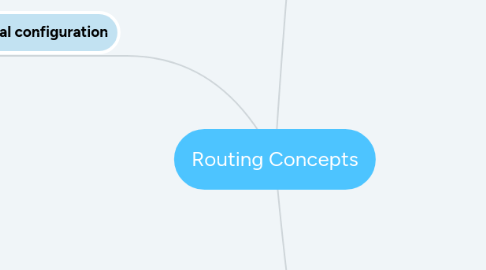
1. Routing initial configuration
1.1. Router functions
1.1.1. Characteristics of a network
1.1.1.1. Topology
1.1.1.2. Speed
1.1.1.3. Cost
1.1.1.4. Security
1.1.1.5. Availability
1.1.1.6. Scalability
1.1.1.7. Reliability
1.1.2. Components of a network capable device
1.1.2.1. CPU
1.1.2.2. Operation System
1.1.2.3. Memory and storage
1.1.3. A router connects multiple networks
1.1.3.1. Has multiple interfaces
1.1.4. Primary functions of a router
1.1.4.1. Determine the best path to send packets
1.1.4.2. Forward packets toward their destination
1.1.5. Packet Forwarding Mechanisms
1.1.5.1. Process switching
1.1.5.2. Fast switching
1.1.5.3. Cisco Express Forwarding
1.2. Connect devices
1.2.1. Connect to a network
1.2.1.1. Home office devices connections
1.2.1.1.1. Laptops and tablets connect wirelessly to a home router
1.2.1.1.2. A network printer connects using an Ethernet cable to the switch port on the home router
1.2.1.1.3. The home router connects to the service provider cable modem using an Ethernet cable
1.2.1.1.4. The cable modem connects to the Internet service provider (ISP) network
1.2.1.2. Branch site devices connections
1.2.1.2.1. Corporate resources connect to Layer 2 switches using Ethernet cables
1.2.1.2.2. Desktop PCs and voice over IP (VoIP) phones connect to Layer 2 switches using Ethernet cables
1.2.1.2.3. Laptops and smartphones connect wirelessly to wireless access points (WAPs)
1.2.1.2.4. The WAPs connect to switches using Ethernet cables
1.2.1.2.5. Layer 2 switches connect to an Ethernet interface on the edge router using Ethernet cables
1.2.1.2.6. The edge router connects to a WAN service provider
1.2.1.2.7. The edge router also connects to an ISP for backup purposes
1.2.1.3. Central site devices connections
1.2.1.3.1. Desktop PCs and VoIP phones connect to Layer 2 switches using Ethernet cables
1.2.1.3.2. Layer 2 switches connect redundantly to multilayer Layer 3 switches using Ethernet fiber-optic cables
1.2.1.3.3. Layer 3 multilayer switches connect to an Ethernet interface on the edge router using Ethernet cables
1.2.1.3.4. The corporate website server is connected using an Ethernet cable to the edge router interface
1.2.1.3.5. The edge router connects to a WAN SP
1.2.1.3.6. The edge router also connects to an ISP for backup purposes
1.2.2. Default gateways
1.2.2.1. IP address
1.2.2.2. Subnet mask
1.2.2.3. Default gateway
1.2.3. Document network adressing
1.2.3.1. The documentation should identify
1.2.3.1.1. Device names
1.2.3.1.2. Interfaces used in the design
1.2.3.1.3. IP addresses and subnet masks
1.2.3.1.4. Default gateway addresses
1.2.3.2. Useful network documents
1.2.3.2.1. Topology diagram
1.2.3.2.2. An addressing table
1.2.4. Enable IP on a switch
1.2.5. Enable IP on a host
1.2.5.1. A host can be assigned IP address information either
1.2.5.1.1. Statically
1.2.5.1.2. Dynamically
1.2.6. Console access
1.2.6.1. Console access requires
1.2.6.1.1. Console cable
1.2.6.1.2. Terminal emulation software
1.3. Router Basic settings
1.3.1. Configure basic router settings
1.3.1.1. Name the device
1.3.1.2. Secure management access
1.3.1.3. Configure a banner
1.3.2. Configure an IPv4 Router Interface
1.3.2.1. Configured with an IP address and a subnet mask
1.3.2.2. Activated LAN and WAN
1.3.3. Configure an IPv6 Router Interface
1.3.3.1. Configured with IPv6 address and subnet mask
1.3.3.1.1. ipv6-address/prefix-length
1.3.3.1.2. ipv6-address/prefix-length link-local
1.3.3.1.3. ipv6-address/prefix-length eui-64
1.3.3.2. Activated
1.3.4. Configure an IPv4 Loopback Interface
1.4. Verify connectivity of directly connected networks
1.4.1. Commands
1.4.1.1. show ip interface brief
1.4.1.2. show ip route
1.4.1.3. show running-config interface
1.4.1.4. show interfaces
1.4.1.5. show ip interface
1.4.1.6. show ipv6 interface brief
2. Routing decisions
2.1. Switching packets between networks
2.1.1. Router switching function
2.1.2. Send a packet
2.1.3. Forward to the next hop
2.1.4. Packet routing
2.1.5. Reach the destination
2.2. Path determination
2.2.1. Routing decisions
2.2.1.1. Directly connected network
2.2.1.2. Remote network
2.2.1.3. No route determined
2.2.2. Best Path - Protocols
2.2.2.1. Routing Information Protocol (RIP)
2.2.2.2. Open Shortest Path First (OSPF)
2.2.2.3. Enhanced Interior Gateway Routing Protocol (EIGRP)
2.2.3. Load Balancing
2.2.4. Administrative Distance
3. Router operation
3.1. Analyze the routing table
3.1.1. The routing table
3.1.1.1. Directly connected routes
3.1.1.2. Remote routes
3.1.2. Routing table sources
3.1.2.1. Local route interfaces
3.1.2.2. Directly connected interfaces
3.1.2.3. Static routes
3.1.2.4. Dynamic routing protocol
3.1.2.5. Codes
3.1.2.5.1. Local - L
3.1.2.5.2. Directly connected - C
3.1.2.5.3. Static route - S
3.1.2.5.4. Dynamically learned network - D
3.1.2.5.5. D using OSPF routing protocol - O
3.1.3. Remote Network Routing Entries
3.1.3.1. Route source
3.1.3.2. Destination network
3.1.3.3. Administrative distance
3.1.3.4. Metric
3.1.3.5. Next-hop
3.1.3.6. Route timestamp
3.1.3.7. Outgoing interface
3.2. Directly connected routes
3.2.1. Directly Connected Routing Table Entries
3.2.1.1. Route source
3.2.1.2. Destination network
3.2.1.3. Outgoing interface
3.3. Statically learned routes
3.3.1. Static Routes
3.3.1.1. Static route to a specific network
3.3.1.2. Default static route
3.4. Dinamic routing protocols
3.4.1. Dynamic Routing
3.4.2. IPv4 Routing Protocols
3.4.2.1. EIGRP - Enhanced Interior Gateway Routing Protocol
3.4.2.2. OSPF - Open Shortest Path First
3.4.2.3. IS-IS - Intermediate System-to-Intermediate System
3.4.2.4. RIP - Routing Information Protocol
3.4.3. IPv6 Routing Protocols
3.4.3.1. RIPng (RIP next generation)
3.4.3.2. OSPFv3
3.4.3.3. EIGRP for IPv6

